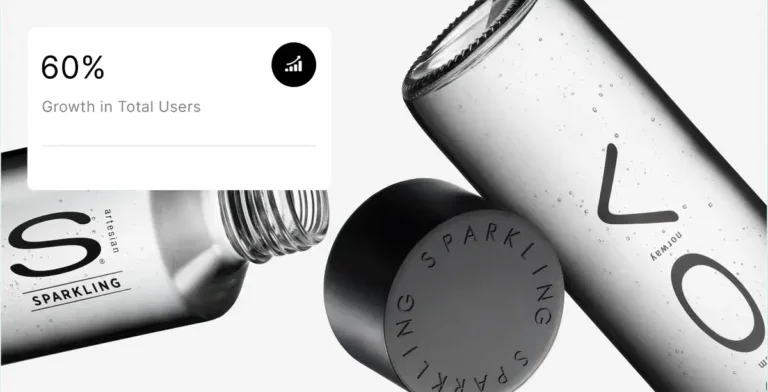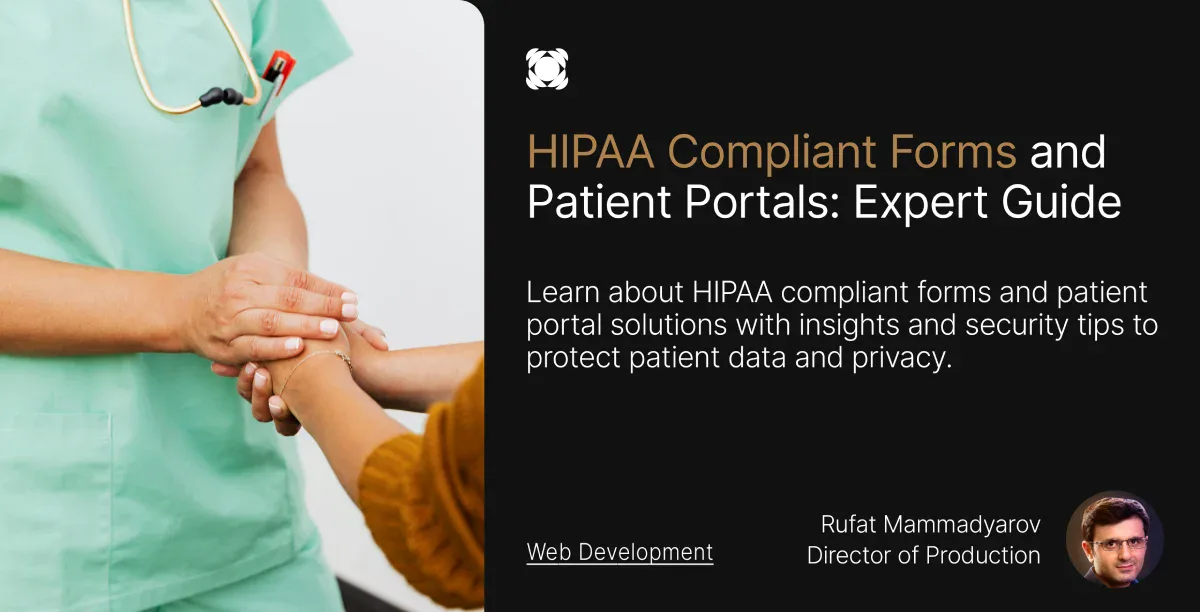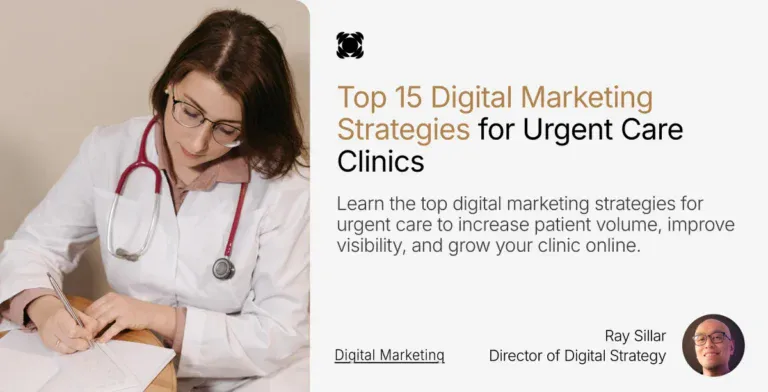Did you know that there will be more than 1.70 billion users all over the world in the digital healthcare market by 2029? This means that it has never been more important to create and optimize a website than right now.
A single HIPAA violation could set you back $50,000, and repeated infractions might lead to annual penalties of $1.5 million. Your HIPAA compliant forms and patient portals do a lot more than just look good. It protects you from devastating financial and reputational damage.
Patient expectations have evolved dramatically. Research shows that 70% of patients expect their healthcare providers to communicate digitally. Secure communication platforms have become crucial.
The decision between open source HIPAA compliant forms and patient portals with a premium solution starting at $25 per user monthly requires careful evaluation.
Patient information protection must remain your top priority. These portals allow patients to access their medical records, test results, and treatment plans safely. They also keep communication open with healthcare professionals.
This article explains core HIPAA rules and the best portal options. It helps you stay compliant and meet your patients’ digital needs.
Trying to build a more secure healthcare website for your business but don’t know where to start? Let us help.
What Makes a Form or Portal HIPAA-Compliant?
HIPAA compliance for digital healthcare forms and patient portals means protecting certain types of information.
This must be done through approved channels. Organizations must understand what information needs protection, who should safeguard it, and why these digital platforms create unique security challenges.
Understanding PHI and ePHI
Protected Health Information (PHI) has any individually identifiable health information that covered entities or business associates hold.
This goes way beyond medical records and includes various data used in healthcare decisions. It isn’t just about medical history; it can reasonably identify someone during their care.
PHI covers:
- Medical and billing records.
- Insurance information.
- Laboratory test results.
- Medical images.
- Wellness program files.
- Clinical case notes.
- Any information used for healthcare decisions.
PHI becomes electronic Protected Health Information (ePHI) when stored, transmitted, or kept in digital format.
This is different.
The HIPAA Security Rule protects this specific type of information. The Security Rule only protects electronic forms of information. It does not cover information shared orally or in writing.
Digital intake forms or patient portals must implement safeguards to protect the 18 identifiers that make health data PHI.
These identifiers range from names and dates to contact information, account numbers, and biometric identifiers.
Covered entities and business associates
HIPAA compliance requirements apply to organizations classified as covered entities or business associates. Your organization’s specific obligations depend on its category.
Covered entities are health plans (insurance companies, government programs like Medicare), healthcare clearinghouses (organizations that process non-standard health information), and healthcare providers who send health information electronically for HHS standard transactions.
Business associates are individuals or companies that work with PHI for covered entities. These include consultants, data disposal companies, technology providers, billing services, and administrators of self-funded health plans.
Business associates must sign Business Associate Agreements (BAAs) that outline their PHI protection responsibilities.
The HITECH Act made business associates directly responsible for Security Rule violations, making compliance mandatory.
Why intake forms and portals are high risk
Patient intake forms and portals can pose security risks. They are key places where sensitive information is collected.
Digital gateways are often the first link between patients and healthcare systems. This can make patients more vulnerable.
Breach consequences go beyond regulatory penalties. Many patients never return after losing trust, leading to patient attrition. These digital portals boost patient engagement but also create substantial security responsibilities.
Digital forms must have technical safeguards like encryption to keep data unreadable if intercepted, detailed access logs to spot unauthorized access, and staff training on security procedures.
Patient portals have similar needs but require extra care. Their interactive features and constant access set them apart.
Key HIPAA Rules That Apply to Digital Forms and Portals
HIPAA has three key regulations that control how you handle patient information in digital forms and portals.
You’ll need to understand these rules to build systems that protect sensitive data while keeping them functional.
HIPAA Privacy Rule
The HIPAA Privacy Rule sets federal standards to protect medical records and other protected health information (PHI). These standards explain what information to protect, who must comply, and how to use it in patient portals and digital intake forms.
This rule covers all health information that can identify people. It applies whether it is held or shared by covered entities or their business associates.
Your digital forms must include proper privacy controls for any patient data you collect.
Covered entities can use and share PHI without patient authorization for treatment, payment, and healthcare operations.
But if your portal shares information beyond these purposes, you’ll likely just need specific patient consent.
The Privacy Rule allows electronic authorizations if the electronic signature is legally valid.
Your patient portal must respect these individual rights:
- The right to get into and copy health records.
- The right to ask for corrections to health information.
- The right to know how their information will be used.
The minimum necessary standard becomes crucial for your portal. You should only collect and show information that is essential for your purpose.
HIPAA Security Rule
The Security Rule protects electronic protected health information (ePHI). The Privacy Rule covers all formats of PHI. This makes it vital for digital forms and patient portals that create, receive, maintain, or transmit ePHI.
You need to have reasonable safeguards to protect patient data. This includes administrative, physical, and technical measures. Your patient portal should ensure:
Confidentiality: Only authorized people can access data Integrity: No one can change or destroy information without authorization.
Availability: Authorized users can access and use data when they need it.
You’ll need to get a full picture of potential risks to ePHI before launching a patient portal. This assessment helps build your security strategy.
Technical safeguards are crucial for digital forms and portals. These include:
- Controls that limit portal access to authorized users.
- Audit tools that track who accessed information and when.
- Controls that prevent unauthorized changes.
- Security measures that protect data during transfer.
Strong authentication is essential for HIPAA compliant patient portals. Simple username and password combos aren’t enough.
You need multifactor authentication. This checks identity using several methods. It helps protect against unauthorized access.
HIPAA Breach Notification Rule
Security incidents can happen even with the best precautions. The HIPAA Breach Notification Rule explains what a breach is.
It also tells you how to respond legally if someone compromises unsecured PHI.
A breach happens when someone acquires, accesses, uses, or shares unsecured PHI in ways HIPAA doesn’t allow.
For patient portals, unauthorized access can be a problem. This could occur with stolen credentials, malware, or sharing wrong information.
After a breach of unsecured PHI, you must notify:
- Affected individuals within 60 days of finding the breach.
- The HHS Secretary (timing depends on breach size).
- Media outlets if the breach affects more than 500 residents in one area.
For breaches affecting 500+ people, you must tell HHS quickly (within 60 days of discovery).
For smaller breaches, you can report annually, no later than 60 days after the year ends.
Individual notifications must be in writing, sent by first-class mail (or email if agreed), and include:
- What happened in the breach.
- Types of information involved.
- Steps people should take to protect themselves.
- Your investigation and prevention plans.
- Contact details for questions.
Creating a breach notification policy with clear timelines, roles, and steps helps you respond quickly if your patient portal gets breached.
Designing HIPAA Compliant Forms
Medical forms need more than just good design. They require careful attention to data protection and privacy standards.
Healthcare organizations must meet key requirements to stay HIPAA compliant. This applies to patient data from start to finish, especially when making documents for patients.
Limit data collection to minimum necessary
The “minimum necessary” standard is the lifeblood of HIPAA compliance. This rule states that you must limit PHI collection and access to what is essential for the intended purpose.
Healthcare forms should collect just enough information to complete specific tasks.
If you want to implement this principle effectively, you must do several things.
First, document your system’s information and clearly categorize different types of PHI.
Next, determine what information the core team actually needs access to. Then, set up role-based permissions that restrict access to certain types of PHI.
Create standardized forms and templates that collect only essential data elements for each specific purpose. This approach reduces risk exposure if a breach occurs. Forms should never ask for information you may need later.
Each form field should answer one question: “Is this critical for treatment, payment, or healthcare operations?”
If not, remove it. Note that collecting unnecessary PHI increases both your liability and security risks.
Your current intake forms might have redundant or unnecessary fields that need elimination. Think about whether you really need to collect social security numbers, driver’s license details, or other sensitive information for immediate healthcare purposes.
Use secure e-signature tools
E-signatures provide great efficiency benefits in healthcare settings.
However, not all e-signature solutions offer adequate security for PHI. HIPAA-compliant e-signatures must be secure, encrypted, and fully auditable.
Your e-signature tools should offer 256-bit encryption, which is vital for documents both in transit and at rest. The system should create detailed audit trails that record when documents are opened, viewed, and signed.
This creates a permanent record that supports signature validity. Your e-signature platform should use strong authentication methods. This can include electronic ID verification, two-factor authentication, security questions, or voice verification.
Note that HIPAA doesn’t specify particular e-signature standards. Healthcare organizations should make sure that any electronic signature leads to a legally binding contract under the law.
Both the Uniform Electronic Transactions Act and the ESIGN Act support e-signatures’ legal standing.
A Business Associate Agreement from your e-signature provider is vital before implementation. You cannot achieve HIPAA compliance without this significant document, regardless of the tool’s security features.
Explore how we reduced Deep 6 AI’s bounce rate by 21% with a website redesign in our latest case study.
Avoid using non-compliant platforms like Google Forms
Urgent care organizations often risk HIPAA violations by using standard consumer-grade form tools. Google Forms isn’t HIPAA compliant by default. Using these platforms without proper security settings creates major liability risks.
Google Forms can work for healthcare organizations under specific conditions. You’ll need a Google Workspace subscription that supports HIPAA compliance and a signed BAA with Google.
The settings must meet HIPAA’s technical safeguards, and staff need proper training.
Standard form builders handle data in ways that conflict with HIPAA requirements. Healthcare organizations should use specialized HIPAA-compliant form solutions instead. These include:
JotForm, FormAssembly, Formstack, Cognito Forms, and FormDr, all offer HIPAA-compliant options with BAA agreements. These platforms have security features. They include encryption, access controls, and audit capabilities to protect PHI.
Your form solution should encrypt data during transmission and storage. Forms are prime targets for data breaches since they collect sensitive information. Collect only essential data. Validate it to guard against attacks.
Also, avoid storing form data in unsecured email.
Your form provider must offer encryption, sign a BAA, and provide detailed compliance documentation about their security measures. The platform’s user-friendliness won’t protect you from severe HIPAA violation penalties otherwise.
Building or Choosing a HIPAA Compliant Patient Portal
Patient portals connect healthcare providers with patients and need strong security measures to protect sensitive health information.
Healthcare providers must pay close attention to technical safeguards that protect data security while keeping the portal easy to use when they create or choose a HIPAA compliant portal.
Role-based access control
Role-based access control (RBAC) is the foundation of a secure patient portal. It ensures the core team can only see information they need for their specific jobs.
Each role has specific data permissions. Nurses see intake forms and vital signs. Billing teams access insurance details. Doctors can view complete medical histories.
Smart contracts can enforce these access rules automatically by checking credentials before allowing access to patient records.
The system immediately ends the session and shows false information as an extra security step if someone tries unauthorized access. This strategy prevents data breaches from compromised accounts or internal threats.
To make RBAC work:
- Define clear roles within your organization.
- Document what specific PHI each role needs.
- Configure technical permissions based on these definitions.
- Review and update access rights as roles change regularly.
Your organization risks security problems and HIPAA violations without proper role separation.
End-to-end encryption
End-to-end encryption (E2EE) keeps third parties from accessing data as it moves between devices. Information stays confidential during transmission.
This security measure encrypts data on the sender’s device. Only the intended recipient can decrypt it. This protects messages, prescriptions, diagnoses, and other sensitive data, even if someone intercepts them.
Patient portals with E2EE need:
The hybrid approach that combines AES (Advanced Encryption Standard) with ECC (Elliptic Curve Cryptography) offers an economical solution for maintaining system security with cloud storage.
This method needs smaller key sizes and uses memory better while keeping computational complexity low.
Users should have public and private keys to store and send medical data safely. The encryption must protect everything in the portal, including messaging features, document sharing, and form submissions.
Audit logs and session tracking
Detailed audit trails record every interaction with protected health information. This creates accountability and helps detect potential breaches quickly.
Your patient portal must track all file views, downloads, and changes. It should include user IDs and exact timestamps.
This is what HIPAA auditors look for during reviews.
Beyond meeting compliance requirements, strong audit logging helps spot suspicious patterns that might signal security issues.
The logs must track:
- Each user login and authentication attempt.
- File access patterns and durations.
- Changes to access permissions.
- Actions taken within applications containing PHI.
Automatic session timeouts protect users by logging them out after inactivity. This stops unauthorized access from unattended devices.
This is important in busy clinical areas where computers may be left alone for a short time.
HIPAA-compliant hosting environments
Your patient portal needs specialized hosting configured for healthcare data. HIPAA-compliant hosting providers undergo regular audits.
These checks ensure they meet the physical, technical, and administrative safeguards needed to protect ePHI.
Look for these features when evaluating hosting options:
Physical security for server hardware is just as important as digital protection. The costs include setup expenses (building infrastructure, implementing consensus mechanisms, deploying smart contracts) and ongoing operational costs for maintenance, security updates, and compliance monitoring.
Several vendors now offer specialized HIPAA-compliant patient portal solutions. Caspio provides a no-code platform. It features customizable workflows, secure role-based logins, and built-in audit trails.
Spruce Health offers a communication-focused platform. It features secure messaging and telehealth tools that integrate with current EHR systems.
Open source options let you customize more but need more technical expertise to set up correctly.
No matter what you build or buy, ensure it meets all security needs listed above.
Also, get a signed Business Associate Agreement (BAA) from any third-party vendors.
Comparing Top Options for HIPAA Compliant Patient Portals
You need to evaluate features, security protocols, and usability carefully when choosing a patient portal solution. Each platform has its own capabilities and follows HIPAA compliance standards.
Let’s look at five leading options:
Caspio

Caspio lets you build custom HIPAA-compliant database applications with minimal coding. Their HIPAA edition includes signed BAAs for full legal protection.
It also features enterprise-grade encryption and detailed access controls.
Healthcare organizations can make patient portals. These portals let patients book appointments online, talk securely with providers, and see test results.
The platform connects to existing healthcare systems through REST APIs and tools like Zapier, which keeps data consistent across departments.
Teams can launch their first working version in just days. This makes it great for quick implementation. You don’t need deep technical knowledge.
CharmHealth
CharmHealth provides a complete EHR solution that protects patient health information with strict security measures.
The platform follows HIPAA rules through reliable access controls, network security, and physical safeguards.
They run ‘Tier 3 Plus’ data centers in Washington with backup facilities in Texas, where specially trained staff work around the clock.
Patients can access health records, talk to providers, schedule appointments, ask for medication refills, and monitor health vitals through their portal.
The platform’s telehealth service offers video calls. You can share your screen, chat via text, and join group sessions.
ClinicTracker

ClinicTracker‘s HIPAA compliant forms and patient portals works seamlessly with their EHR system. Patients can check their medical info anytime. They can view appointment history, medication lists, and lab results. The system allows patients to book appointments when providers are available.
They can also fill out forms and pay bills online using credit cards.
A secure messaging system helps patients communicate with their care team while following HIPAA rules.
Healthcare providers can customize the portal with their logo, colors, and contact info. This boosts their brand and streamlines workflows.
Spruce Health
Spruce Health leads the market in HIPAA-compliant healthcare communication, serving more than 25,000 providers and 5 million patient accounts.
They combine secure messaging, phone features, SMS texting, video calls, and e-fax in one system.
Security measures include two-factor authentication and automatic logout after 30 days of no activity, plus Face ID or Fingerprint ID options. Their phone system includes call routing, voicemail transcription, and phone trees. These features help connect patients with the right team members.
Healthie

Healthie provides a complete HIPAA-compliant EHR platform that works perfectly for private practices. The platform brings together charting, scheduling, billing, and client records.
It also features strong encryption and secure access controls. You get essential communication tools like HIPAA-compliant email, built-in chat, and telehealth through Zoom for Healthcare.
Urgent care practitioners can cut down on technology tools and still stay compliant. The platform meets all data security and privacy standards. This approach lets clinicians use fewer tools to manage everything.
So, security oversight becomes easier.
Best Practices for Implementation and Staff Training
Patient portals need constant watchfulness that goes well beyond the original setup.
Healthcare security systems are often weak due to human error. So, organizations must focus on maintenance and education.
Conduct regular risk assessments
Risk analysis is the life-blood of HIPAA security compliance and helps identify threats to patient data. Your first step should be documenting all systems with ePHI.
Then you need to review threats to confidentiality, integrity, and availability of this information. Both technical infrastructure and operational processes need analysis during the assessment.
Risk assessments should happen continuously rather than just once to address changing circumstances. Your team should review security implications before implementing new technologies or procedures.
This proactive strategy helps prevent new vulnerabilities in your portal system.
Train staff on secure data handling
HIPAA requires training for all new team members soon after they join your organization.
You’ll need additional training any time policies change significantly. Healthcare organizations see annual refresher training as a best practice, even if it’s not required by regulations.
Effective training programs should:
- Test trainees during sessions to ensure comprehension.
- Keep sessions brief to maintain attention.
- Include real-life consequences of HIPAA breaches.
- Mix compliance training with general security awareness.
Your team should keep clear records of all training activities. This includes what was covered, who attended, when they completed it, and the test results.
Create a breach response plan
A detailed breach response strategy helps you prepare for potential incidents, even with preventive measures in place. This plan needs to cover containment procedures, investigation methods, and notification protocols.
A possible breach needs a quick evaluation of PHI compromise. Use the four-factor risk assessment process.
This process looks at the nature of the exposed information, who received it without authorization, whether they actually viewed the PHI, and how much risk mitigation occurred. Your notification requirements under the Breach Notification Rule depend on this assessment.
The core team should practice their responsibilities through simulated incidents.
These exercises make response plans work better during actual breaches.
Get a Custom Healthcare Web Design that Converts With Blacksmith
HIPAA compliant forms and patient portals are nowhere near just technological tools. They protect patient privacy and your organization’s future.
When a single violation can lead to penalties of up to $50,000 per incident, it’s vital to have one created that covers every single big issue you might face.
But let’s face it, creating HIPAA compliant forms and patient portals is no weekend project.
In fact, it can take weeks, if not months, depending on the complexity of your website and how secure you want it to be. This is time you could be using on other important parts of your business as well, so what now?
That’s where we come in. Blacksmith is a healthcare web design company with a group of professional web designers ready to create the ideal HIPAA compliant forms and patient portals for your healthcare business.
From complete encryption to preferred hosting environments, we’ll ensure your healthcare business is completely safe from breaches and any potential HIPAA violations.
Still unsure if investing in HIPAA compliant forms and patient portals is the right move for your business? Don’t worry, click here to schedule a call with us and we’ll provide you with a complete brand audit.
This way we can show you any vulnerabilities and security risks your website might have and how HIPAA compliant forms patient portals can fix them for you.









